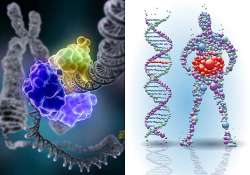Metabolism is linked with gene regulation reveals a study
Toronto: In a discovery that holds promise for the understanding of many diseases, including cancer, researchers have discovered a new way by which metabolism is linked to the regulation of DNA - the basis of

Toronto: In a discovery that holds promise for the understanding of many diseases, including cancer, researchers have discovered a new way by which metabolism is linked to the regulation of DNA - the basis of our genetic code.
The DNA wraps around specialised proteins called histones in the cell's nucleus.
Histones keep the DNA tightly packaged, preventing the expression of genes and the replication of DNA which are required for cell growth and division.
In order for critical functions to take place, histones need to be modified with the attachment of an acetyl-group, donated by a critical molecule called acetyl-CoA.
The research team, led by post-doctoral fellow Gopinath Sutendra from University of Alberta, discovered that an enzyme thought to reside only within mitochondria - Pyruvate Dehydrogenase Complex (PDC) - can actually find its way into the nucleus and do what it is designed to do in the mitochondria: generate acetyl-CoA.
This attachment relaxes the DNA, allowing for DNA replication and gene expression.
"This mechanism is called 'epigenetic regulation of DNA' and is important for normal functions like the growth of an embryo or brain functions or in common diseases like heart failure or cancer," Sutendra explained.
Until now, how the nucleus generates acetyl-CoA for histone acetylation had remained elusive.
Because the findings relate to how our DNA is regulated in general, this work may have far broader implications for many physiologic or pathologic conditions where epigenetic regulation is critical," Sutendra added.
"We are very excited about this new pathway linking energy production (the process known as metabolism) with gene regulation," researchers said in a paper published in the journal Cell.
The DNA wraps around specialised proteins called histones in the cell's nucleus.
Histones keep the DNA tightly packaged, preventing the expression of genes and the replication of DNA which are required for cell growth and division.
In order for critical functions to take place, histones need to be modified with the attachment of an acetyl-group, donated by a critical molecule called acetyl-CoA.
The research team, led by post-doctoral fellow Gopinath Sutendra from University of Alberta, discovered that an enzyme thought to reside only within mitochondria - Pyruvate Dehydrogenase Complex (PDC) - can actually find its way into the nucleus and do what it is designed to do in the mitochondria: generate acetyl-CoA.
This attachment relaxes the DNA, allowing for DNA replication and gene expression.
"This mechanism is called 'epigenetic regulation of DNA' and is important for normal functions like the growth of an embryo or brain functions or in common diseases like heart failure or cancer," Sutendra explained.
Until now, how the nucleus generates acetyl-CoA for histone acetylation had remained elusive.
Because the findings relate to how our DNA is regulated in general, this work may have far broader implications for many physiologic or pathologic conditions where epigenetic regulation is critical," Sutendra added.
"We are very excited about this new pathway linking energy production (the process known as metabolism) with gene regulation," researchers said in a paper published in the journal Cell.